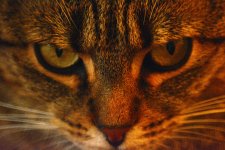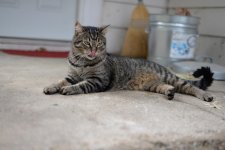I've deleted the images, but I was there trying all the different speeds in S mode because the images were practically black (with Auto ISO off and adjusting values to see if it would make a difference). I kept getting the 'subject too dark' message at 1/125sec. I was shooting towards the window as the speaker had the window behind him and to the side. At 1/125 I switched on Auto ISO and the EXIF data showed the ISO was 3200 and the image was still very dark and very noisy. So I switched to A mode (played with different aperture numbers) and the camera selected around 1/20 sec and ISO 3200. The images in A mode are well exposed enough but blurry (and the moving hand is all blur, no shape). I was in a well lit room, the speaker was standing near the window so we had sunlight and overhead ceiling lights. Then I tried auto-no-flash and the EXIF data showed f/5.6, ISO 3200, 1/30 and there is some blur. It seems ISO was going right up to 3200 when I had Auto ISO on. When I was manually changing the ISO and shutter speed, again everything was dark and the 'subject too dark' was happening around 1/125sec. I understand why the camera says 'subject too dark, cannot adjust exposure' (in the technical sense)... but I didn't think I'd be getting that (and black photos) at 1/125 shooting in a well lit room. Does it seem okay that Auto ISO was going up to 3200? I will re-read everything and try again. I scribbled down notes based on the advice given in this thread but no luck. I worked in IT for twenty years and I'm quite confident the problem here is the user and not the hardware, so I don't want to say there's something wrong with the camera. The user, on the other hand... * Sorry, still can't get this to display as separate paragraphs. I tried the shift+enter tip but no change.
You are using an out of date browser. It may not display this or other websites correctly.
You should upgrade or use an alternative browser.
You should upgrade or use an alternative browser.
'Subject is too dark' on a bright sunny cloudless day at noon
- Thread starter boofhead
- Start date
Actually I'd be interested to hear your thoughts on settings for the following scenario: indoors, taking a photo of a cat washing itself so that you freeze action and see the cat's tongue (or photographing a cat as it is yawning). Not much natural light, so the ceiling lights would be on during the day. Standing arms length away from the cat. If using S mode, what settings would you suggest starting with? I'll try them out and see what happens with my camera. I'm interested in S mode seeing as it's giving me grief, though please feel free to suggest what you would do in A mode and I'll try that too.
If there is a movement then the shutter speed required is generally more than 1/125 sec, preferably 1/250. That with low light will surely jack up the ISO required. I normally use F1.8 exclusively in indoor situations, unless there is a lot of light - flood light on the stage. One trick to use in such situations is to set the exposure compensation to -1EV or even -2EV. The meter will give a fast shutter speed. You just correct the exposure in post. The noise after correction will be comparable (or at times less) to raising the ISO, but the brighter portions generally have less noise.
Actually I'd be interested to hear your thoughts on settings for the following scenario: indoors, taking a photo of a cat washing itself so that you freeze action and see the cat's tongue (or photographing a cat as it is yawning). Not much natural light, so the ceiling lights would be on during the day. Standing arms length away from the cat. If using S mode, what settings would you suggest starting with? I'll try them out and see what happens with my camera. I'm interested in S mode seeing as it's giving me grief, though please feel free to suggest what you would do in A mode and I'll try that too.
Best bet
. Use a F1.8 AF lens to get the settings first at F1.8 and then at say F2.8 in "A" mode. If Speed is too low go upto ISO 800. If that is still low, use flash.
. Use the above settings with the non CPU lens.
Otherwise if speed is too low, hope that the subject does not move at 1/20 sec
I have gotten a lot of these frozen action shots of my cats, but they are generally outdoors.Actually I'd be interested to hear your thoughts on settings for the following scenario: indoors, taking a photo of a cat washing itself so that you freeze action and see the cat's tongue (or photographing a cat as it is yawning). Not much natural light, so the ceiling lights would be on during the day. Standing arms length away from the cat. If using S mode, what settings would you suggest starting with? I'll try them out and see what happens with my camera. I'm interested in S mode seeing as it's giving me grief, though please feel free to suggest what you would do in A mode and I'll try that too.
When I am shooting the cats, my camera is usually on Scene/Pet portrait/Continuous High.
I have gotten some acceptable shots indoors, too, with a variety of lenses. But my first lens purchase is a "normal" prime lens, like film cameras used to come with! I can only afford 1.8 though.
I have to go to work right now, but I would love to share some pics with you.
Here is one, anyway, indoors. With my 500mm Nikon f8 reflex, handheld, D5200:

Last edited:

